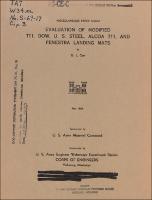Please use this identifier to cite or link to this item:
https://hdl.handle.net/11681/20759Full metadata record
| DC Field | Value | Language |
|---|---|---|
| dc.contributor | United States. Army Materiel Command | - |
| dc.contributor.author | Carr, Gordon L. | - |
| dc.date.accessioned | 2017-01-17T21:34:21Z | - |
| dc.date.available | 2017-01-17T21:34:21Z | - |
| dc.date.issued | 1969-05 | - |
| dc.identifier.uri | http://hdl.handle.net/11681/20759 | - |
| dc.description | Miscellaneous Paper | - |
| dc.description | Abstract: This report describes investigations conducted to evaluate six different metal landing mats, as well as one of the mats that was modified after initial testing. Four of the items tested are fabricated from extruded aluminum and two are fabricated from steel. These investigations consisted of engineering traffic tests to obtain information for use in comparing the performance of the mats with project requirements, which are summarized in Appendix A of this report. The traffic tests were conducted on each mat placed on a prepared subgrade with a CBR of approximately 4. These tests were conducted with a single-wheel load of 25,000 lb with tires inflated to 250 psi, and tire contact area of 111.1 sq in. to simulate F-4c aircraft operations. The service life criterion for an experimental mat was 200 coverages. Results of these investigations revealed the following: (A.) The U. S. Steel Type 4.5A mat withstood 62 actual coverages on a 4-CBR subgrade, the equivalent of 31 percent of the traffic criterion. (B.) The Dow MX18-A and a modified T11 mat sustained 30 actual coverages, the equivalent of approximately 20 percent of the traffic criterion (40 and 45 coverages, respectively, when related to performance on a 4-CBR subgrade). These mats were considered undesirable. (C.) The Alcoa T11, U. S. Steel Type 3.5A, modified U. S. Steel Type 4.5A, and Fenestra mat failed after 2 to 6 actual coverages. It is recommended that none of these mats be considered for further investigation until the designs are modified as indicated by results of these tests, fabrication techniques are improved, and quality control measures are established. In conjunction with this series of engineer design tests, four other mats were tested and they met the project requirements. These mats were the Kaiser MX19, Dow MX18-B, Dow MX18-C, and U. S. Steel Type 4.5 Air-Dek. Development of the MX19 and the MX18-B mats is continuing. NOTE: This file is large. Allow your browser several minutes to download the file. | - |
| dc.publisher | U.S. Army Engineer Waterways Experiment Station. | - |
| dc.publisher | Engineer Research and Development Center (U.S.) | - |
| dc.relation | http://acwc.sdp.sirsi.net/client/en_US/search/asset/1048966 | - |
| dc.rights | Approved for public release; distribution is unlimited. | - |
| dc.source | This Digital Resource was created from scans of the Print Resource | - |
| dc.subject | Landing mats | - |
| dc.subject | Airfields | - |
| dc.subject | Trafficability | - |
| dc.subject | Tests | - |
| dc.subject | Testing | - |
| dc.subject | Evaluation | - |
| dc.title | Evaluation of modified T11, Dow, U.S. Steel, Alcoa T11, and Fenestra landing mats | - |
| dc.type | Report | en_US |
| Appears in Collections: | Miscellaneous Paper | |
Files in This Item:
| File | Description | Size | Format | |
|---|---|---|---|---|
| MP-S-69-17.pdf | 39.34 MB | Adobe PDF |  View/Open |